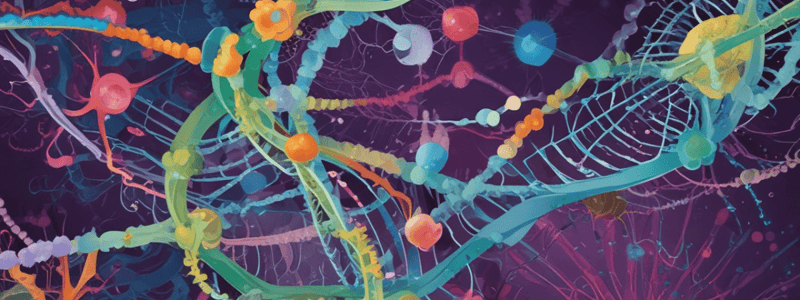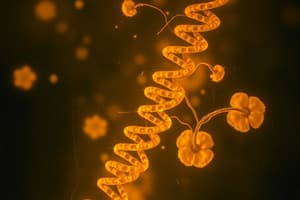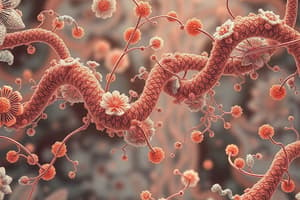Podcast
Questions and Answers
What is the primary function of the operator in the lac operon?
What is the primary function of the operator in the lac operon?
- To bind the repressor protein and prevent transcription (correct)
- To bind lactose and induce gene expression
- To bind RNA polymerase and initiate transcription
- To bind the lacI gene and regulate its expression
What is the outcome of induction in the lac operon?
What is the outcome of induction in the lac operon?
- Inhibition of RNA polymerase
- No change in gene expression
- Repression of gene expression
- Activation of gene expression (correct)
What is the key difference between negative and positive regulation?
What is the key difference between negative and positive regulation?
- Negative regulation is default off, while positive regulation is default on (correct)
- Negative regulation is inducer-dependent, while positive regulation is repressor-dependent
- Negative regulation is specific to the lac operon, while positive regulation is specific to the trp operon
- Negative regulation is default on, while positive regulation is default off
Which of the following is an example of positive regulation?
Which of the following is an example of positive regulation?
What is the role of the lacI gene in the lac operon?
What is the role of the lacI gene in the lac operon?
What is the primary function of the promoter in the lac operon?
What is the primary function of the promoter in the lac operon?
What is the primary function of cis-elements in gene regulation?
What is the primary function of cis-elements in gene regulation?
Which of the following is a mechanism of post-transcriptional regulation?
Which of the following is a mechanism of post-transcriptional regulation?
What is the primary outcome of epigenetic regulation?
What is the primary outcome of epigenetic regulation?
What is the role of coactivators in transcriptional regulation?
What is the role of coactivators in transcriptional regulation?
Which of the following is a mechanism of transcriptional regulation?
Which of the following is a mechanism of transcriptional regulation?
What is the primary function of trans-acting factors in gene regulation?
What is the primary function of trans-acting factors in gene regulation?
What is the reason behind the ribosomes' preference for a particular reading frame?
What is the reason behind the ribosomes' preference for a particular reading frame?
What is the mechanism by which the p32 protein regulates its own translation?
What is the mechanism by which the p32 protein regulates its own translation?
What is the function of the ribosomal proteins in the regulation of ribosome synthesis?
What is the function of the ribosomal proteins in the regulation of ribosome synthesis?
How do ribosomal proteins recognize their own mRNA?
How do ribosomal proteins recognize their own mRNA?
What is the consequence of having excess ribosomal proteins?
What is the consequence of having excess ribosomal proteins?
What is the mechanism of regulation of ribosomal protein synthesis?
What is the mechanism of regulation of ribosomal protein synthesis?
What is the purpose of grouping several genes into a polycistronic operon?
What is the purpose of grouping several genes into a polycistronic operon?
What is the outcome of the interaction between the protein ribosomal S8 and the 16S rRNA?
What is the outcome of the interaction between the protein ribosomal S8 and the 16S rRNA?
Why do some phages require a specific order of protein appearance during their infection mechanism?
Why do some phages require a specific order of protein appearance during their infection mechanism?
What is the function of the Shine-Dalgarno sequence in mRNA translation?
What is the function of the Shine-Dalgarno sequence in mRNA translation?
What is the role of the secondary structure of the mRNA in protein translation?
What is the role of the secondary structure of the mRNA in protein translation?
Why might some proteins in an operon need to be translated in greater quantities than others?
Why might some proteins in an operon need to be translated in greater quantities than others?
What is the significance of the height of the peaks in the diagram shown?
What is the significance of the height of the peaks in the diagram shown?
What is the outcome of the binding of the protein ribosomal S8 to the 16S rRNA in the ribosome?
What is the outcome of the binding of the protein ribosomal S8 to the 16S rRNA in the ribosome?
What might be the consequence of translating all the genes in an operon in equal quantities?
What might be the consequence of translating all the genes in an operon in equal quantities?
How do successive ribosomes translate previously masked mRNA sequences?
How do successive ribosomes translate previously masked mRNA sequences?
What is the purpose of the secondary structure of the mRNA in regulating protein translation?
What is the purpose of the secondary structure of the mRNA in regulating protein translation?
What is the purpose of adjusting the translation of some genes in an operon?
What is the purpose of adjusting the translation of some genes in an operon?
Why do some mRNAs form a curved structure to regulate protein translation?
Why do some mRNAs form a curved structure to regulate protein translation?
What is the outcome of the translation of previously masked mRNA sequences by successive ribosomes?
What is the outcome of the translation of previously masked mRNA sequences by successive ribosomes?
Flashcards are hidden until you start studying
Study Notes
Operon Regulation
Lac Operon
- A genetic regulatory system found in E. coli
- Controls the expression of genes involved in lactose metabolism
- Consists of:
- Promoter: binds RNA polymerase
- Operator: binds repressor protein
- Structural genes: lacZ, lacY, and lacA
- Regulator gene: lacI
Negative Regulation
- A type of regulation where a repressor protein binds to the operator, preventing transcription
- In the lac operon, the lac repressor protein binds to the operator, preventing RNA polymerase from transcribing the structural genes
- Negative regulation is "default off" - genes are not expressed unless the repressor is removed or inhibited
Induction and Repression
- Induction: the process of activating gene expression by removing the repressor
- Repression: the process of inhibiting gene expression by binding the repressor to the operator
- In the lac operon, lactose acts as an inducer, binding to the repressor and preventing it from binding to the operator
Positive Regulation
- A type of regulation where an activator protein binds to the promoter, increasing transcription
- In contrast to negative regulation, positive regulation is "default on" - genes are expressed unless the activator is removed or inhibited
- Examples of positive regulation include the ara operon and the maltose operon
Trp Operon
- A genetic regulatory system found in E. coli
- Controls the expression of genes involved in tryptophan biosynthesis
- Consists of:
- Promoter: binds RNA polymerase
- Operator: binds repressor protein
- Structural genes: trpE, trpD, trpC, trpB, and trpA
- Regulator gene: trpR
- The trp operon is negatively regulated by the trp repressor protein, which binds to the operator in the presence of tryptophan
Studying That Suits You
Use AI to generate personalized quizzes and flashcards to suit your learning preferences.




